
Health Update: Latricia (Jan 2021)
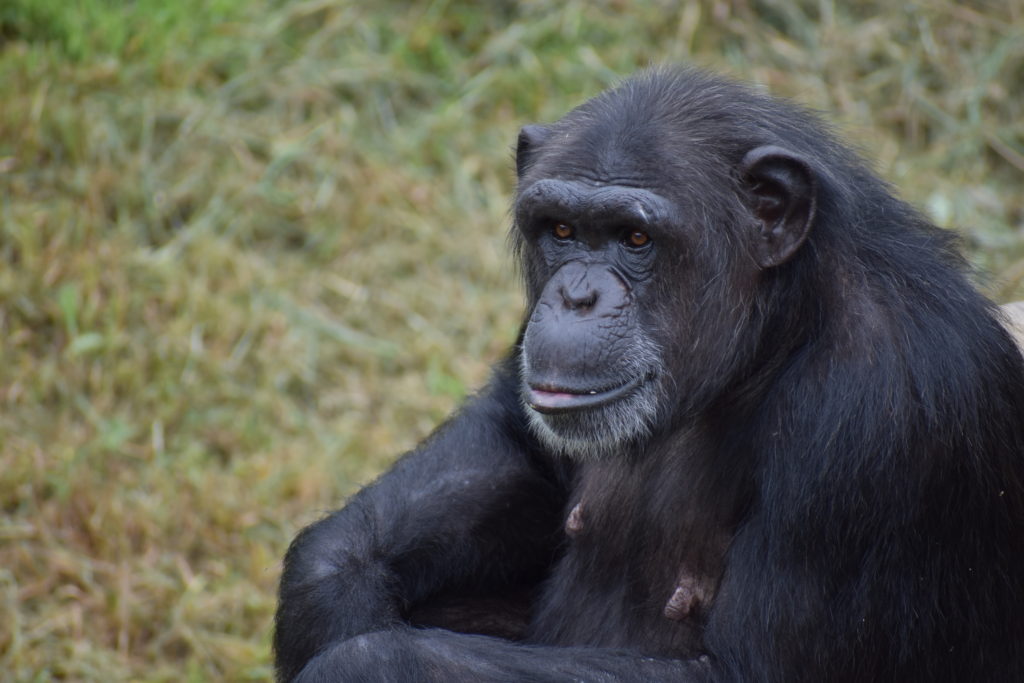
Latricia, or Trish as we call her, has always been a tough lady, a real leader in her group. She is the kind of chimp that marches to the sound of her own drum. She is a kind leader, always backing up the younger girls when the boys get rowdy. She loves blankets and spends much of her time outdoors. Latricia is wary of new foods but will never pass on a banana. She must warm up to her caregivers before she will really interact with them, but once she does your fast friends.
Lately Trish has been having some issues with her sex skin, or swelling, as it is commonly called. This area naturally can get very large and swollen and stay that was for 10 days or more depending on a multitude of factors including group dynamics. It is a very important social cue used in the wild for matting and other social factors.
How an abscess forms
It is also common for chimps, both males and females, to be curious and explore the female swellings when they are, well, swollen. Unfortunately, this poking and prodding can introduce bacteria to the area. If a scratch is made inside the vagina and bacteria is introduced, the body will heal around it, trapping the bacteria inside. This is how an abscess might form.
Most abscesses are impossible to see until they get large, which most do not because the body will fight the infection and clear it up naturally. However, sometimes this doesn’t happen. As a result, the abscess can grow quite large and even form draining tracts, which are infective paths from the abscess to the outside world. This draining action gets most of the infected material out and the bacteria are killed by oxygen and light.
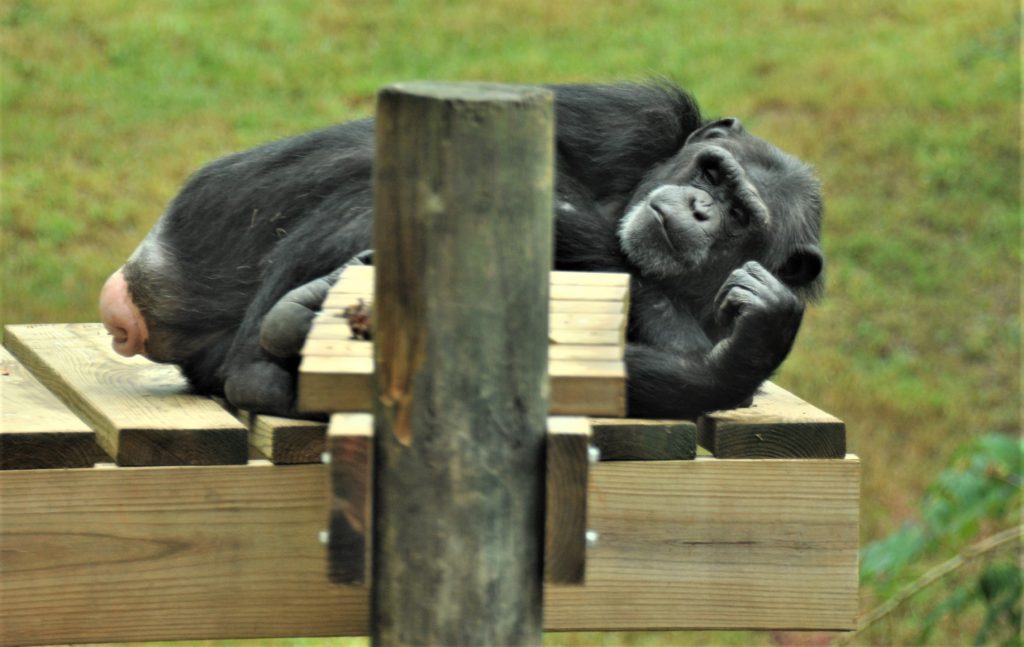
Latricia’s backside
Recently, Trish’s swell became quite enlarged and as stated, that is not unusual; a very large swell can be natural depending on where the chimp is in her cycle. But Trish stopped eating some of her food, which was our first sign that she was not ok. Upon closer inspection, her swelling was not even, and we believed she had an abscess.
We watched Latricia closely over the next day and when she didn’t seem any better, we started her on oral antibiotics and anti-inflammatories. We noticed two areas that looked like the abscess was about to rupture, which is a natural and positive process for an abscess.
After a team discussion, we decided that we may need to intervene with a hands-on procedure, which would involve sedation. As sedations themselves carry high levels of risk, we wanted to wait until it was medically necessary.
Well, before we made a final decision on intervening, the abscesses popped on their own and in doing so, tore a large blood vessel in her backside. She lost a lot of blood.
The team quickly mobilized, and she was sedated and treated immediately.
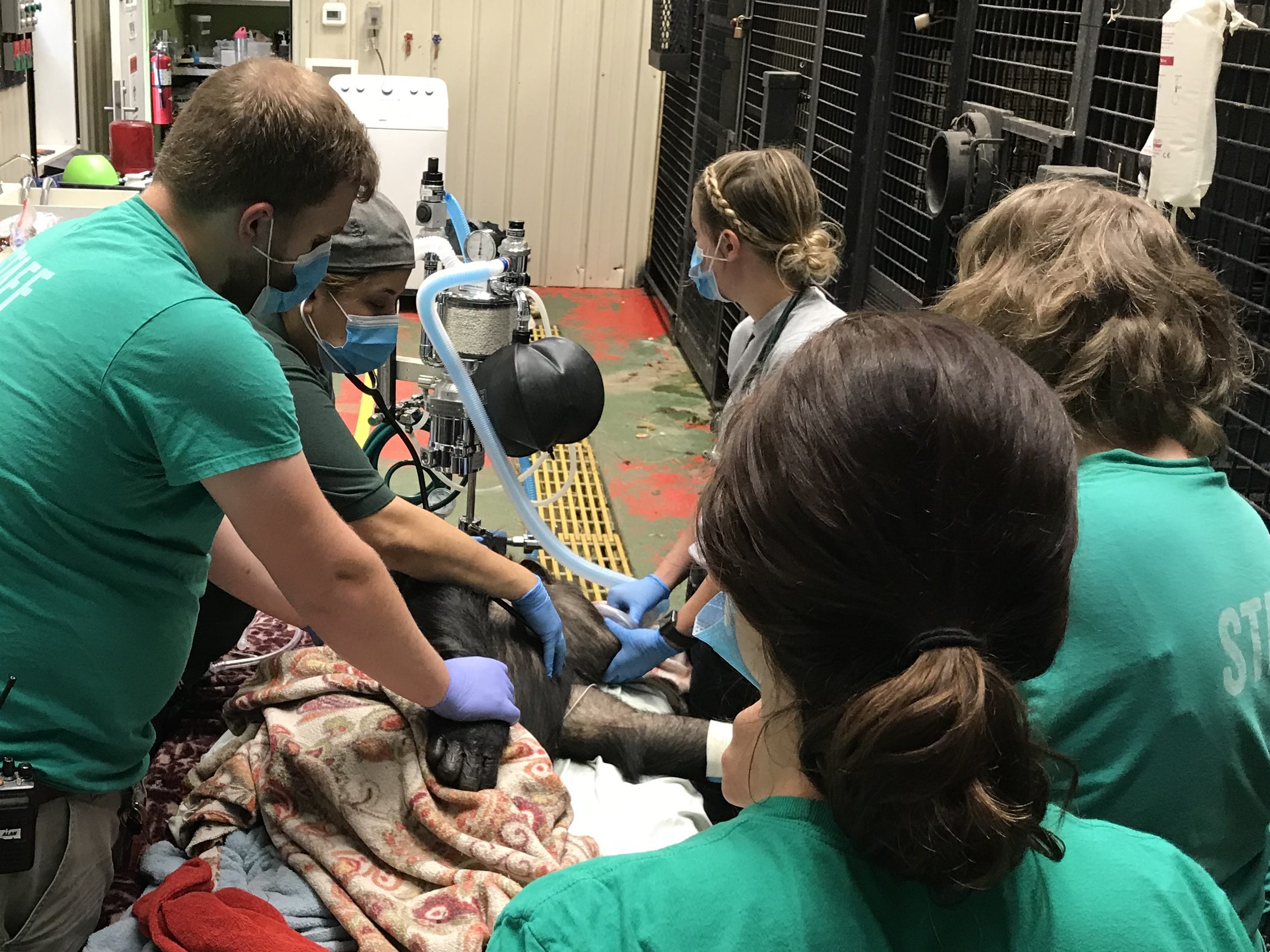
The medical team
A five-person medical team moved like clockwork: Person 1: applying anesthesia equipment; Person 2: intubating her to have an open airway; Person 3: placing an IV line; Person 4: drawing blood samples for testing, giving injections of vitamins, pain medications, and antibiotics; and Person 5: flushing and cleaning the wound.
There was a lot of work to do but everyone on the team did great. The veterinarian performed the procedures and a full physical exam. We found several large draining tracts running along her leg, which is very unusual.
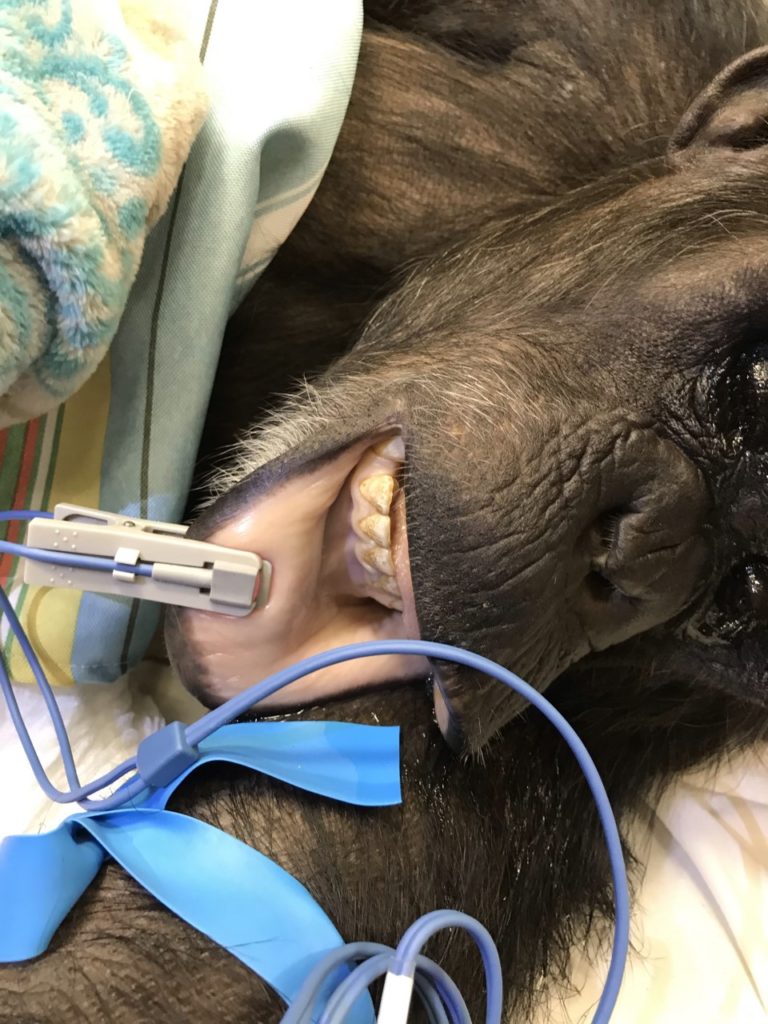
With the use of contrast imagery, which essentially means we probed the wound with a long piece of material that shows up very well on radiographs, we were able to explore all the draining tracts to see how deep they were and if they communicated with any other parts of her body. We were able to confirm the tracts were not a more serious condition called a fistula (an abnormal connection between two body part) coming from the large intestine. We were also able to determine that Latricia has a grade 3/6 heart murmur, which is also very unusual for females and for her age.
Trisha’s wounds were flushed and cleaned, then packed with antibiotics. The torn vessels were ligated to prevent further bleeding. She woke up from anesthesia groggy, but fine.
The next few days we focused on Trish’s treatment and recovery. Her blood work revealed she had an inappropriate, non-regenerative, iron deficient anemia and a severe increase in all her white blood cells; additionally, her liver was a little inflamed. Latricia was in critical condition but the tireless efforts of the care staff seem to be working, slowly, as little by little she has been getting her strength and appetite back.
Not out of the woods
Unfortunately, Trish’s gums didn’t become pink like the way yours or mine should look and which are a sign of health; instead they stayed pale.
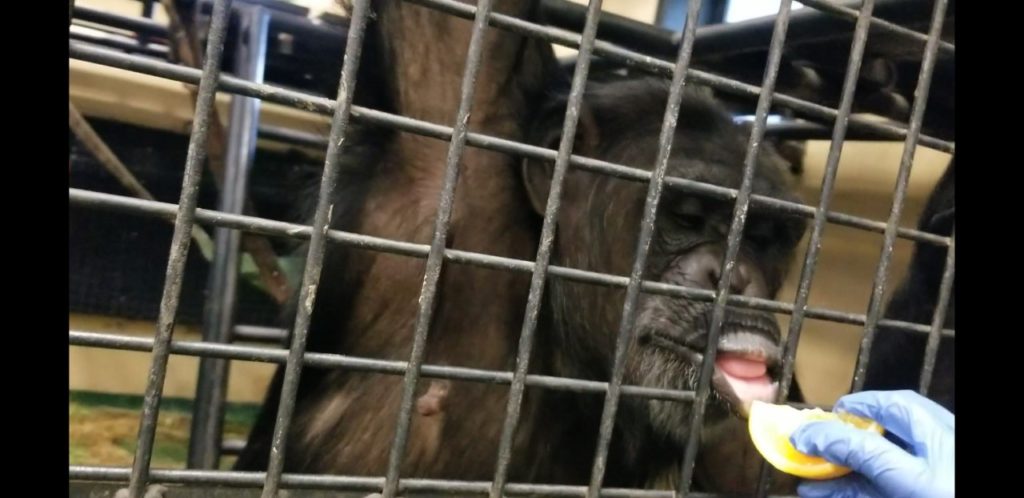
So, we made the judgement call to sedate her again and it is fortunate we did. Her anemia had not improved at all, in fact, it has worsened.
Latricia’s buddy, Jennifer, stepped up to help and loaned us some blood to perform a blood transfusion. Jennifer was a match because most chimps born in captivity have the same blood type. By doing a quick major cross match test we were able to see that their blood types were compatible. Also, unlike humans, chimps have less antibodies in their blood cells so are less likely to reject blood from a transfusion.
Both procedures went exceedingly well, and the recovery has been smooth. Day by day, Latricia started to appear more like her old self. She became the playful, “watch mom”, and sometimes troublemaker, she has always been. Trish continued to get antibiotics, anti-inflammatories, iron supplements and liver supplements. Not to mention special fluid therapy and extra liquid nutrition. She even seemed to like all the special treatment.
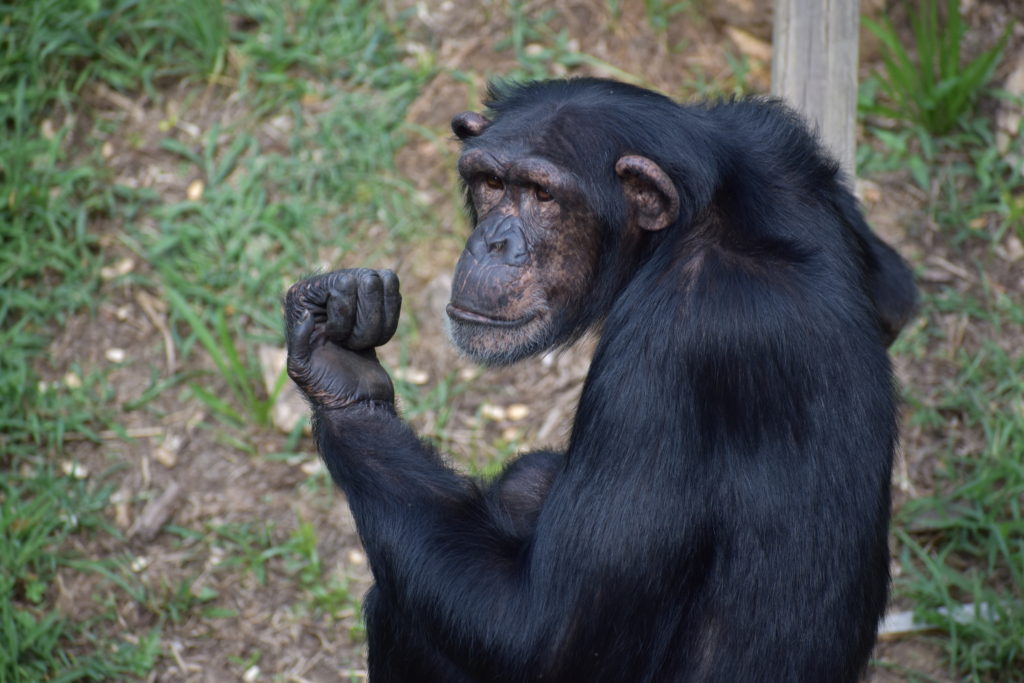
Another recheck
Two weeks after the first sedation, we once again asked Trish to go into the squeeze area and present us a leg or arm for injection. She voluntarily cooperated.
We took more blood samples, ensured the abscess was healed, and her heart murmur was now a 2/6. The whole procedure was very quick, and she was up and about ready to play with her friends in under an hour.
Her bloodwork showed she is still having iron deficient anemia but had improved 100% over her previous tests.
The final prognosis
We believe the infection got into Latricia’s bone marrow and stopped her from making red blood cells. The infection overwhelmed her body and if we hadn’t caught it when we did, she would not be alive today.
Losing Latricia would be a travesty because she is one of the coolest girls in that group, just ask her.
We are discussing plans for another follow up in a few months to have a chimpanzee specialist in echocardiography complete a full exam on Trish’s heart and grab, hopefully, the last blood sample we will need to close this scary chapter in what we are hopeful for will be a long and happy book.
Latricia is currently on supplements to help heal her liver and increase her iron. You can help us keep our pharmacy stocked by visiting our wishlist here.
